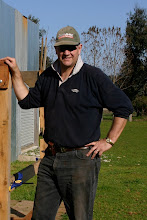Back in early December things got really wet at Moora Farm - for the first time (for us). Then it got dry - and just over a week ago I actually found young trees in the orchard and trufferie with some water stress. That caused me to start watering via the drip irrigation systems we have installed.
The watering regime that was laid down for the truffles is pretty water efficient. It involved 5 litres per tree 3 times a week. As the sprayers deliver 35 litres an hour, each zone runs for just 12 minutes each watering. It's pretty amazing to me that, with only minimal monitoring from me, the system will apply water successively to each of the zones - at a time I dictate - and never forget to do it!
Last week we had another rain event - another 152 mm of beautiful soft steady rain spread over 4 days. That's a quarter of our normal annual rainfall. This system is the tail end of what caused the problems in Queensland - and the same rain event that has caused flooding elsewhere in Victoria.
We are very fortunate where we are in that our vulnerability to flooding is pretty limited. We're close to the top of the hill (ie limited capacity for 'flash flooding'), we have good ground cover, we're not too steep, but also not flat. We get to take up a goodly amount of the rain in the soil profile, fill our dams to overflowing and then pass the excess down the watershed without any erosion.
However, we do have one thing to deal with. The cattle are on the paddock - and it got very, very wet. Near the end it seemed like the ground was soaked and there was a inch of water lying on top of the ground anywhere it could.
 I had 50 cattle confined to a strip that was 30 metres wide and 110 metres long. They could then get back to the water trough via another strip 9 metres wide and 60 metres long.
I had 50 cattle confined to a strip that was 30 metres wide and 110 metres long. They could then get back to the water trough via another strip 9 metres wide and 60 metres long. The first photo shows what happened to the route to the water trough - very thoroughly churned up with no visible pasture in the worst parts of it.
The second photo shows the wet strip running through the middle. In the foreground and to the left is the previous strip - which is not churned up at all. In the backgound the cows are already in the subsequent strip - which is grazing fine with no pugging at all.
The next thing I will do is paddock harrow to spread the manure around and tickle things up. Up to now (3 days later) - it is still too wet.
This paddock is a mixture of perennial ryegrass, cocksfoot, phalaris and clovers. It got a bit of a beating last winter when we used it to feed hay through July and August. Most of the paddock recovered really well, but there are bare patches along the highest part of the paddock where the bales were set out.
Those bare patches came back with weeds rather than pasture. Obviously the water trough strip is also at risk of this ... so today I came up with a solution - which came from my attendance at a Joel Salatin Seminar.
I went to the seed company in Ballarat that supplied the original pasture seeds and got three separate seeds mixes:
- one called Sheep n' Beef 600 mm mix - which is what I have minus the phalaris
- one called Forage Blend Plus - which is 50% Winifred Brassica, 20% Tonic Plantain and 30% Chicory
- an Italian ryegrass called Crusader.
Whenever there is an opportunity - and paddock harrowing after grazing will be the main one - I'm going to hand spread a mix of these mixes on any bare spots and pugged areas - and basically anywhere I think I can get it to strike.
I'm hopeful that this will increase my pasture diversity - and, with the compost, chicken manure and better manure utilisation, it will boost pasture production.
F





No comments:
Post a Comment